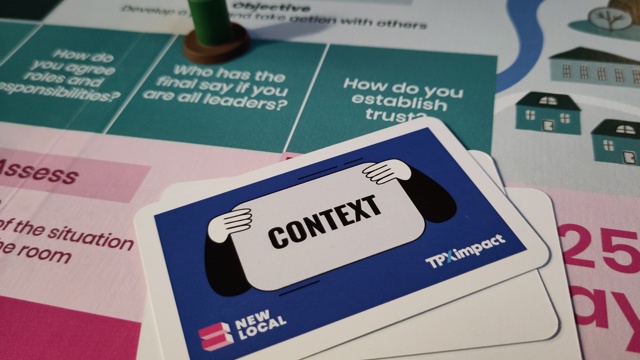“Only a crisis – actual or perceived – produces real change.”
- Milton Friedman
As we move beyond the Covid-19 pandemic, and grapple with new and urgent problems such as the soaring cost of living, there’s a danger that we might lose some of the valuable lessons that were forged in that crisis.
We have come to a reckoning point: in the context of global challenges including economic and environmental uncertainty, we have choices to make about the world we want to live in. This is an opportunity to reimagine the world, and to remodel our organisations in a way that will help us bring about this change.
So what key lessons can we take on board from the pandemic to make this happen? How can we organise ourselves in the public sector to multiply the value and impact of our public services?
1) Become an agile organisation, don’t just deliver agile projects
Being agile means delivering work iteratively, testing, learning and adapting a product or service along the way. It’s different to the traditional, waterfall method of working, which involves researching, planning, designing, building, and then testing after launch. Working in an agile way allows teams to be more flexible, and respond to changes in accordance with user needs.
But being agile can’t be limited to individual projects or pieces of work. It needs to be embedded into the DNA of an organisation’s processes, systems and culture. That’s not currently reliably the case across the public sector, a fact which helps to explain the service backlogs resulting from the Covid-19 pandemic, as organisations struggle to flex and adapt.
2) Anchor all activities in purpose and vision
Purpose is the reason something exists or why something is done or created. And a vision statement is how an organisation can move from that purpose into action. Whether it’s representing economic change in a city or describing the future of Adult Social Care or a regional transport system, a vision outlines the end state everyone should be prioritising and working towards.
Ideally, a vision should be bold, to light up an alternative to the current status quo. Digital Salford, the North West initiative to increase Salford’s digital capabilities and investment potential, has a strong vision to establish the city as a leading UK digital economy. That vision, aligned to purpose, has helped shape current investments, which improves outcomes for local people.
3) Promote transparency and accountability
Building an open and accountable culture that is founded on trust and transparency is key to getting everyone working towards an organisation’s vision. That means empowering teams of specialists to work with shared goals rather than in traditional functional silos. It means ensuring they can connect and collaborate outside of their immediate teams and with other organisations over the long term. And it means giving them a clear sense of ownership about the part they’re playing in making that vision a reality — and the space to make it happen.
The multidisciplinary teams who came together to solve urgent health, childcare or education needs during the pandemic are a great example of this approach in action.
But openness and accountability can also underpin how an organisation works with its end users, too. Wigan Council’s Deal, launched to combat budget cuts in 2010, clearly sets out roles and responsibilities for both the council and local residents. For example, the Council promised to keep Council Tax low, in return for residents recycling more. This approach has led to the Council reducing its expenses, while improving services and health outcomes for citizens.
4) Change the narrative
Even if we can’t change the circumstances, we can always change the story around them. The narratives we buy into can challenge our existing beliefs, and shape what we collectively believe is possible. That’s incredibly powerful, especially as we are faced with increasing global challenges and constraints.
Blackpool’s ongoing transformation is a great example of a place that’s reshaping its own story. The town’s high deprivation and unemployment rates cast a shadow over its bright lights. But Blackpool Council has started to shift its narrative with a new vision positioning the town as a serious investment option. Pioneering digital and aerospace projects are shifting investor perceptions and writing a new, better story and future for local communities.
5) Be service-led
A service-oriented organisation aligns all its internal business activities around user needs and outcomes. Operating in this way is a multiplier, as it increases the value and impact of what these organisations can achieve for people.
Parkinson’s Connect, a service developed by the charity Parkinson’s UK, is a case in point. It was co-created with its users, helping the organisation to understand and meet their needs through initiatives such as personalised care and Digital Health Assistants.
Models of the world we want to build
Organisations that remodel and rewire themselves along these lines can multiply their impact to meet the needs of our changing world. To be more flexible, open and inclusive. To deliver better, more joined up services. And to reshape society for future generations.
You can find out more about how we can rebuild our organisations to meet modern needs, in our new book Multiplied, available from Amazon and Waterstones.
Multiplied explores the new and creative ways in which we can unlock the technology, data and design potential of the public sector, to do more for Britain’s communities. All profits from the book are being donated to the Association of NHS Charities.

Introducing Multiplied - a new book about public sector digital transformation
Multiplied focuses on how we can unlock more of the potential of technology, data and design in the public sector, while also working more closely with communities.
Read moreOur recent insights
Transformation is for everyone. We love sharing our thoughts, approaches, learning and research all gained from the work we do.

The role of play in building leadership skills
How play can offer local government leaders a powerful tool to break free from rigid structures.
Read more
Place and infrastructure: thinking about digital transformation in a new way
Digital transformation is more than gadgets or sensors—it's about the intentional and adaptive design of policy, planning and project delivery to achieve user and economic outcomes.
Read more
How agile practices and user-first approaches are key to creating joined-up NHS digital services.
Read more


